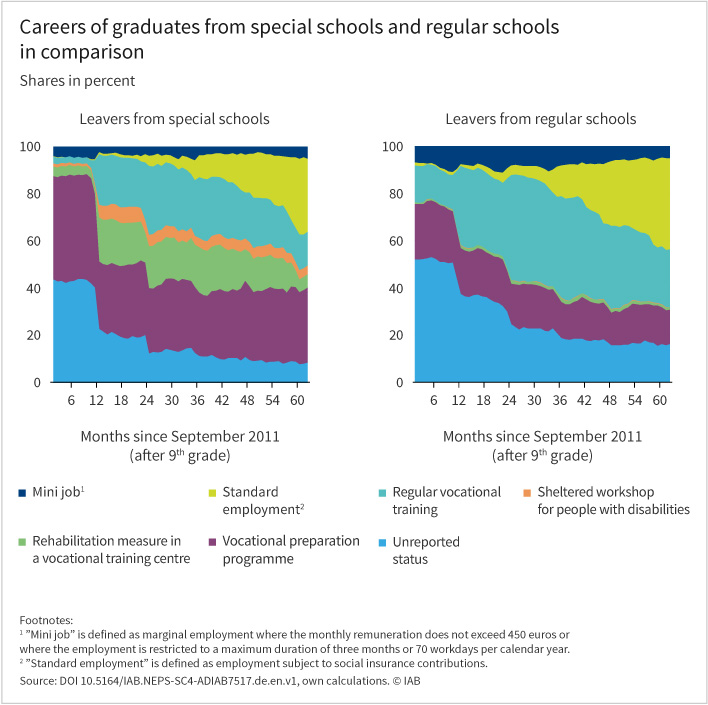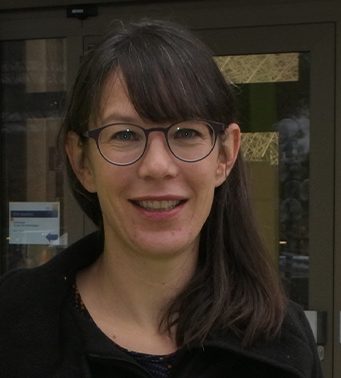8. February 2022 | Groups of Persons
Disadvantaged young people find the transition from school to work particularly difficult

The transition from school to work is considered successful if young people smoothly enter vocational education and training immediately after leaving school and take up employment thereafter. For most young people in Germany, vocational training takes place in companies. However, in reality, there are many more complex transition paths than this ideal. Unemployment, phases of illness, dropping out of vocational training or unclear career aspirations can delay either individual steps in the school-to-work transition or the entire transition phase.
In Germany, support programmes in the so-called “transition system” (“Übergangssystem”: pre-vocational training preparing students to start vocational training) and the subsidised vocational training system – for example, in the form of company-external vocational training or assisted vocational training in firms – are intended to mitigate against long-term problems on the labour market. The programmes are not only intended to reduce the shortage in vocational training positions in companies, especially in times of tight labour markets. They also aim at supporting the vocational integration of socially disadvantaged young people. Socially disadvantaged are groups of young people who, due to their individual requirements, have limited opportunities in the school-to-work transition and therefore need additional support. These include low-qualified school leavers as well as young people whose families cannot provide adequate support when leaving school or whose career prospects are limited due to illness or disability.
These support programmes are in parts viewed critically. For example, it is argued that participants are only kept in waiting loops or that programme participation is even perceived as a stigma by some employers. All of this can make the transition to regular vocational training and employment more difficult.
Three recent empirical studies by the Institute for Employment Research (IAB) focus on the transition experiences of different subgroups of young people in Germany and the importance of support programmes in the transition from school to work. The studies examine the sequence and duration of vocational training, programme participation, and labour market activities of young people over a period of several years after leaving school. The following summary of the findings illustrates similarities and differences in the pathways of young people after leaving school and shows social, health, and educational differences that are related to the transition biographies.
In the first study, published in 2020, Juliane Achatz, Kerstin Jahn, and Brigitte Schels focus on young people with lower or intermediate secondary school leaving certificates (“Hauptschulabschluss” or “Realschulabschluss”). They investigate the importance of characteristics, such as growing up in- families on social welfare, for their school-to-work transition. The second study, written by Nancy Reims and Brigitte Schels in 2021, examines this research question for young people with disabilities who receive vocational rehabilitation services. There has hitherto been little evidence on the pathways of young people with disabilities after leaving school. The third study, published in 2021 by Laura Menze, Malte Sandner, Silke Anger, Reinhard Pollak, and Heike Solga, provides first evidence on the transition to vocational training and employment for young people who have attended a special needs school due to special educational needs. Students from regular schools after 9th grade serve as the comparison group here.
Transition experiences of young people with low and intermediate school qualifications
The first study identifies differences in the transition pathways of around 9,500 young people who have acquired a lower or intermediate secondary school leaving certificate. It observes a period of six and a half years after graduating from school. The focus is on youths who left school during the economic and financial crisis in 2008 (see info boxes “Data” and “Methods”): the largest group (one third) took up employment promptly after completing regular vocational training – thus corresponding to the German normative ideal of a smooth transition. The group makes up around half of the young people if one also includes those who go through short phases of career orientation or job search before or after vocational training. The other half is spread over different pathways. These also include young people who continue their education on secondary school level II or school-based vocational training.
Of particular interest are those school leavers who complete subsidised vocational training (around 7 percent). Compared to the smooth path via regular vocational training, their transition from school to work involves more steps, some of which include short times of unemployment, but then stabilizes. Six years after leaving school, most of them are in employment. A relatively small group of school leavers – 2 percent in the study – face particular risks of a fragile discontinuous transition pathway. They repeatedly become unemployed and do not become established in vocational training or employment for a longer period. Young people who leave school without a qualification or with a lower secondary school leaving certificate (“Hauptschulabschluss”) are more likely to have a pathway with subsidised vocational training or a fragile discontinuous transition biography than young people with an intermediate secondary school leaving certificate (“Realschulabschluss”).
The socio-economic background of the family of origin is also significant for the school-to-work transition, even with the same educational qualification. School leavers from families on social welfare benefits (the so-called “Unemployment Benefit II” in Germany which is a means-tested basic income support for job seekers and their households) are more frequently in the group at risk of repeated unemployment. The risk is also exceptionally high for young people who grow up in families continuously receiving social welfare during the three years before the young person left school.
Young people from families receiving social welfare are, however, also more likely to go through regular vocational training or subsidized vocational training than young people from families who do not claim benefits. Thus, growing up in a family on social welfare benefits is a risk factor in the school-to-work transition. Some of these young people gain biographical stability through vocational training in firms and financial relief through the training wage. However, in contrast to the risk group of the repeatedly unemployed, these are mainly young people from families who received social welfare benefits only temporarily.
Transition experiences of young recipients of vocational rehabilitation
According to Section 19 of the German “Social Security Code III”, young people with disabilities are entitled to benefits for participating in working life (“Leistungen zur Teilhabe am Arbeitsleben” – LTA) due to their disability or their special educational needs. Those benefits are, for example, vocational preparation programmes, company-external vocational training or assisted vocational training. The programmes are often disability-specific, i.e. they facilitate additional psychological, physiotherapeutic, or educational support in the company or a special facility. This can be a vocational training center (“Berufsbildungswerk”) or a facility for the rehabilitation of the mentally ill.
The second study analyses how these institutional conditions shape the transition pathways of recipients of vocational rehabilitation over a period of six and a half years after leaving school in 2008 (see info boxes “Data” and “Methods”). Amongst the 15,723 people examined, 52 percent attend special needs schools. Six different transition pathways emerge.
The largest group of young recipients of vocational rehabilitation, 30 percent in the study, initially attend vocational orientation and vocational preparation measures before they begin company-external vocational training. However, only in a few cases does this lead to employment. A further 19 percent also complete company-external vocational training and then mostly take up employment. 15 percent – and thus comparatively few – complete regular vocational training, which predominantly leads to employment. The pathway of another group, 17 percent in the study, can generally not be traced in the administrative data.
Two further groups are noteworthy here: a smaller group of 7 percent learn vocational skills in a sheltered workshop for young people with disabilities immediately after school, which almost always leads to employment in a sheltered workshop. Another group of 11 percent first goes through vocational orientation and vocational preparation measures after school but then switch between unemployment, support measures, phases of employment, and phases of unknown status. This pathway resembles the fragile transition process of the adolescents without disabilities from the first study but is evident to a greater extent in the group of young recipients of vocational rehabilitation.
In addition, the school leaving certificate plays an essential role in the school-to-work transition within the group of young recipients of vocational rehabilitation. Those who leave school with no more than a lower secondary school leaving certificate are less likely to take the path from vocational training towards employment and are more likely to fall into the group with fragile transition pathways than those who have an intermediate secondary school leaving certificate.
There is also a clear correlation with the type of disability. The path to company-external vocational training is typical for young people with a learning disability; pathways within a sheltered workshop for people with disabilities are most prevalent amongst people with a mental or psychological disability. If vocational rehabilitation starts immediately after leaving school, a smoother transition to vocational training and employment is more likely. Factors associated with more fragile pathways include a delayed entry into vocational rehabilitation and the receipt of social welfare benefits in the household.
Transition experiences of students with special needs
In Germany, special needs schools are still the standard educational path for children and young people with special educational needs because of diagnosed learning difficulties. So far, there are few empirical studies on the transition path of students with special needs. However, these are important because special needs schools are supposed to support young people’s vocational integration. Class sizes in special needs schools are smaller, and students receive more individual support and career counselling.
In the debate about the social inclusion of students with special needs, there is also criticism of the special needs school system. One argument is that special needs schools create an environment of underperformance and that attending one can have a stigmatising effect, which makes getting a job later more difficult. In the third study, the post-school careers of 471 young people who obtained their school leaving certificate at a special needs school are compared with those of 1,092 graduates from regular schools (lower secondary schools (“Hauptschule”) or comprehensive schools). The study period extends over five years after the end of 9th grade in September 2011 (see info box “Data”).
In the special needs schools for children with learning difficulties, the lower secondary school leaving certificate (”Hauptschulabschluss”) is the only realistically attainable school leaving certificate. Higher degrees such as an intermediate secondary school leaving certificate (”Realschulabschluss”) or a university entrance diploma (”Abitur”) are not attainable in these types of schools. At the end of 9th grade (at around 15 years of age), 37 percent of the school leavers in the special needs schools and 91 percent in the regular schools have a lower secondary school leaving certificate. The others leave school without a certificate.
Both groups have difficulties gaining access to vocational training directly after leaving school. Accordingly, transition measures play an essential role. However, this is more common amongst school leavers from special needs schools. Around two years after the end of 9th grade, 44 percent of those who had attended a regular school and 28 percent of those who had left a special needs school are in regular in-company vocational training (see figure).

For those young people who attended a special needs school, vocational rehabilitation measures that take place in a vocational training centre or a sheltered workshop also play an important role. In contrast, more school leavers from regular schools are in activities that are not in detail reported in the administrative data (see info box ”Data”). This is presumably due to the fact that students from regular schools more often continue their general education in order to achieve a higher school leaving certificate than students from special needs schools.
The analyses also show that the differences between the two groups persist even when comparing young people who graduated from special needs school with a lower secondary school leaving certificate with those who graduated from regular schools with such a leaving certificate. However, school leavers from special needs schools who attained a school leaving certificate still do better than young people who did not obtain this certificate.
Conclusion
In Germany, vocational training that predominantly takes place in companies, shapes the careers of school leavers in the lower and intermediate secondary educational segment and represents the norm for an ideal transition from school to work. Support programmes are intended to create alternative training opportunities for disadvantaged young people who otherwise face limited opportunities of accessing regular vocational training.
Support programmes do not play a significant role in the pathways of most school leavers from secondary schools without disabilities – even in times of the economic and financial crisis of 2008. In contrast, for young people with disabilities participation in support programmes is rather the rule than the exception. With the help of those programmes, young people receive a timely connection to vocational training after finishing school. For many of them, however, this is followed by breaks and periods of unemployment when they start working. Since the support programmes for young people were scaled back in times of the improved economic situation after 2008, it can be assumed that the careers shaped by supported programmes have lost some of their quantitative importance.
Young people with disabilities or with special educational needs sometimes pass through highly institutionalised pathways in which the course is set at an early age, in particular by attending a special needs school. For young people with mental or psychological disabilities, the pathway often leads to participation in a sheltered workshop for people with disabilities. From there, the intended transition to employment on the primary labour market is rare.
Amongst young people with disabilities, in particular, the group with fragile discontinuous pathways is extensive, which indicates that the current German support system has limited success in integrating these young people. It should be noted that the studies presented do not constitute causal analyses. They did not evaluate whether the young people at special needs schools or in a workshop setting can learn in a protected space that is necessary because of their special needs, or whether they are held back in their possibilities. This question will be investigated in future work.
The likelihood of a successful transition into regular vocational training in contrast to subsidized training is unevenly distributed not only amongst young people without specific support needs but also amongst young people with disabilities or special educational needs. School qualifications play a central role throughout. They do not have a lower importance for young people who have further support needs. On the contrary, disadvantages accumulate so that young people from families on benefits and those with disabilities often face a double burden. In addition to the school leaving certificate, the family’s economic situation and the type of disability are decisive.
In the European Union, promoting the employment opportunities of all young people is an exceptionally high priority. Compared to many other countries, Germany has a highly differentiated school-to-work transition system. The aims and content of the support programmes are aligned with regular vocational training. The system draws interest in many European countries, mainly because vocational training in companies is regarded as particularly successful in easing the transition to employment and integrating low-qualified young people. The findings of the studies reviewed in this article show that support programmes are an essential instrument to build bridges in the school-to-work transition. Still, programmes do not provide equally good alternatives for all school leavers. Given the diverse needs of young people, for example, with regard to their family situation, health, and disability status, further considerations are necessary regarding how the programmes can address the individual needs of young people.
Data
The studies presented use administrative data of the Federal Employment Agency (FEA), which contain reports from employment data (including in-company vocational training), unemployment and participation in labour market policy measures. The data provide detailed information on specific forms of transition measures and vocational preparation programmes as well as on vocational training in companies and employment subject to social insurance contributions. However, there is no information on activities that are not in the responsibility of the FEA, such as general schooling of secondary level II, school-based vocational education, parental leave, or other activities. Therefore, the careers of the young people surveyed also contain phases with unreported status information.
The studies 1 and 2 link the administrative data with personal information from data of the career counselling service provided by the FEA. The latter data also contains information on the year of school leaving and the type of school. For the year 2008, for example, the group of school leavers with lower or intermediate secondary school leaving certificates who have made use of career counselling can be identified. Even if the data from career counselling are not representative for all school leavers in Germany, there is a good approximation of the actual distribution in the school leaving cohort with regard to school-leaving qualifications. The survey population of the first study comprises a 5 percent random sample – a total of 9,975 people. Study 2 relates to 15,723 school leavers with disabilities who received vocational rehabilitation provided by the FEA. The observation period in both studies spans July 2008 to December 2014.
Study 3 uses administrative data that is available for participants in the National Education Panel Study (NEPS-AdIAB Startkohorte 4). The so-called NEPS starting cohort 4 surveyed students from all over Germany who were in 9th grade of a regular school in autumn 2010 or at special needs schools for young people with learning difficulties.
Methods
The exploration of different pathways in studies 1 and 2 is based on sequence analyses. To perform sequence analyses, the data used are organised as individual month-by-month histories in chronological order after leaving school. For each person in the samples, there is information on the labour market activities (e.g. vocational preparation measures, regular vocational training, subsidized training, unemployment, employment) over all months in the observation period.
Sequence analyses compare the careers of the young people in pairs and determine statistical measures for their similarity. In both studies, the optimal matching procedure was applied. Then, cluster analysis methods (here using the Ward method) use the calculated similarity measures to merge people with similar careers into groups that can be interpreted as typical pathways in the school-to-work transition. An article by Katja Dlouhy and Torsten Biemann published in 2015 gives a good overview of the methods applied. The pathway types are then the target variables of a multinomial logistic regression, which determines the probability of being assigned to a specific type based on selected characteristics.
Literature
Achatz, Juliane; Jahn, Kerstin; Schels, Brigitte (2020): On the non-standard routes: vocational training measures in the school-to-work transitions of lower-qualified youth in Germany. Journal of Vocational Education & Training. DOI: 10.1080/13636820.2020.1760335
Blossfeld, Hans-Peter; Roßbach, Hans-Günther; von Maurice, Jutta (eds.) (2011): Education as a Lifelong Process – The German National Educational Panel Study (NEPS). Zeitschrift für Erziehungswissenschaft, Special Issue No 14.
Dlouhy, Katja; Biemann, Torsten (2015). Optimal matching analysis in career research: A review and some best-practice recommendations. Journal of Vocational Behavior, No 90, pp. 163–173.
Menze, Laura; Sandner, Malte; Anger, Silke; Pollak, Reinhard; Solga, Heike (2021): Jugendliche aus Förderschulen mit Schwerpunkt “Lernen”: Schwieriger Übergang in Ausbildung und Arbeitsmarkt. IAB-Kurzbericht No. 22.
Reims, Nancy; Schels, Brigitte (2021): Typical school-to-work transitions of young adults with disabilities in Germany – a cohort study of recipients of vocational rehabilitation services after leaving school in 2008. Disability and Rehabilitation. DOI: 10.1080/09638288.2021.1948115.
doi:10.48720/IAB.FOO.20220208.01
, ; Reims, Nancy; Sandner, Malte; Schels, Brigitte (2022): Disadvantaged young people find the transition from school to work particularly difficult, In: IAB-Forum 8th of February 2022, https://www.iab-forum.de/en/disadvantaged-young-people-find-the-transition-from-school-to-work-particularly-difficult/, Retrieved: 24th of April 2024
Authors:
- Nancy Reims
- Malte Sandner
- Brigitte Schels

 Dr Nancy Reims is researcher in the department "Joblessness and Social Inclusion" at the IAB.
Dr Nancy Reims is researcher in the department "Joblessness and Social Inclusion" at the IAB.  Dr Malte Sandner is a senior researcher in the department "Education, Training, and Employment Over the Life Course" at the IAB.
Dr Malte Sandner is a senior researcher in the department "Education, Training, and Employment Over the Life Course" at the IAB. PD Dr Brigitte Schels has been a member of IAB's research staff since September 2005.
PD Dr Brigitte Schels has been a member of IAB's research staff since September 2005.